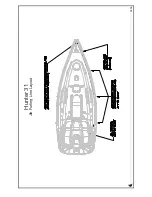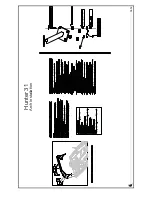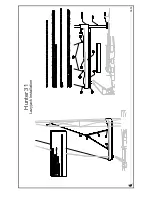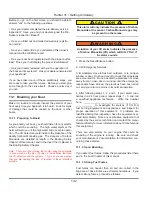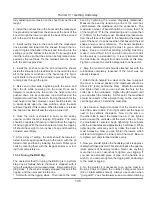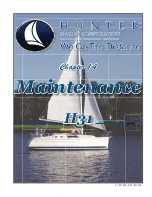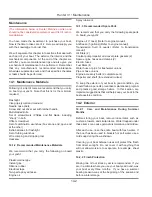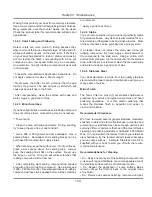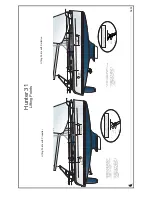
Hunter 31 • Getting Underway
13.6
harness or Bosun’s Chair intended for this use. Always
tie into the harness with the halyard using a bowline and
then secure the shackle as a back up as the knot is more
reliable than a mechanical fastner. The person hoisting
you aloft should keep the halyard stopper closed to pre-
vent falls. Good communication between the two of you
is also important. Tighten the D2 until it has just become
tight ened then add two complete turns. While at the
first spreader, look up the back of the mast to see if it is
straight (rather than bent from side to side). If it is not
straight then adjust the appropriate D2 to straighten it.
7. Have the person on deck carefully lower you. They
should keep the halyard wrapped at least twice around
the winch and should always have one hand able to stop
the halyard from running free. Once on deck, look up
the back of the mast and see if it is straight (rather than
bent from side to side). If not, then adjust the lowers (D1)
until it is.
8. If you have the standard rig, you need to attach the
struts at this time. Attach the lower end of the strut to
the smaller hole in the chainplate. Adjust the length by
turning the ball joint bearing in the upper end of the strut
until the holes in the pin can be attached. It is normal to
have some play between the strut and the chainplate and
strut bracket.
9. The final test is to go sailing in 10-15 knots of wind. If,
when sailing upwind, the shrouds on the leeward side are
slack then tighten them to remove about half the slack
keeping note of the number of turns. Then tack and do
the same to the other side. Do this until you are happy
with the tension and the leeward side does not get loose
when the boat is heeled. Now, sight up the mast to be
sure it is still relatively straight from side to side. If it is
not then adjust to appropriate rigging to correct it. For
example: If the mast is straight until the upper spreader
and then hooks to the windward side, then you will have
to revisit steps 6 and 7 above. Remember to always
tighten the new leeward shroud, tack and tighten the new
leeward shroud the same amount. This prevents dam-
age to the turnbuckles and is also much easier to do.
Keep in mind it is also possible to have something too
tight such as a diagonal shroud.
10. At this point, you should have adequate headstay ten-
sion. The sails are built for an average of 14” (350mm)
of headstay sag, possibly more or less, depending upon
light or heavy air. The bend in the standard mast should
be about 1% (maximum) of “P” and 2” (25mm) (maxi-
mum) in the furling mast and it should be nearly straight
from side to side when sailing upwind. If any of these are
not true, then revisit the appropriate step above to correct
it. If the sag in the headstay is too much then adding ten-
sion to the verticals will fix it.
11. Once the rig is tuned, you should make sure to add
the cotter pins to all the rigging, bending back the ends
and taping them to prevent snagged lines, sails, and
fingers.
Remember that rigging, like everything else, can age. As
it gets older, it may need to be replaced. The frequency
for which this becomes necessary depends on the climate
and conditions in which the boat is sailed. For example:
If you sail in the Caribbean, it should be replaced every 2-
3 years compared to every 10 years for the Great Lakes.
You should consult a professional rigger for advice.
13.4 Returning to Port
After completing the day’s cruise and mooring your boat,
shut down the engine.
* Reduce engine speed to idle. Place transmission con-
trol in neutral. Allow engine to idle for a few minutes.
* Move switch to OFF to shut down the engine.
Before going ashore, check the following items:
Shore power on and plugged in
Battery charger operating
Shaft and rudder log for leaks
A thorough washdown of your hull, decks, and rigging
with soap and fresh water will help keep your boat looking
like new for years.
Note: See the AC Electric section in this manual for information
on connecting the shore power, and the Water Systems chapter
for information on connecting the dockside water supply.
13.5 Emergency Operations
You should always understand and be prepared to
engage in Emergency Operations aboard your boat. The
sea is unforgiving in this area, and you can find yourself
in very bad trouble in a very short time, even if you are
prepared.
Do not rely on this manual to educate you in all the
•
•
•
Summary of Contents for H31
Page 1: ...Operator s Operator s Manual Manual H31 H31 V1 031507 P N 1031379 ...
Page 2: ......
Page 9: ...Introduction Introduction H31 H31 Chapter 1 Chapter 1 V1 031507 P N 1031379 ...
Page 14: ...Hunter 31 Introduction 1 6 Notes ...
Page 15: ...V1 031507 P N 1031379 and Documents Documents Forms Forms H31 H31 Chapter 2 Chapter 2 ...
Page 26: ...Hunter 31 Documents and Forms Maintenance Log Date Maintenance Performed Hourmeter 2 12 ...
Page 27: ...Hunter 31 Documents and Forms 2 13 Date Maintenance Performed Hourmeter Maintenance Log ...
Page 33: ...Hunter 31 Documents and Forms 2 19 Spare Parts List ...
Page 34: ...Hunter 31 Documents and Forms Dates of practice drills and onboard safety inspections 2 20 ...
Page 35: ...Hunter 31 Documents and Forms 2 21 My personal preferences for maintenance items safety gear ...
Page 36: ...Hunter 31 Documents and Forms Notes 2 22 ...
Page 37: ...V1 031507 P N 1031379 Warranty Warranty H31 H31 Chapter 3 Chapter 3 ...
Page 38: ...This Page Intentionally Left Blank Hunter Warranty 3 2 ...
Page 45: ...Boating Boating Safety Safety H31 H31 Chapter 4 Chapter 4 V1 031507 P N 1031379 ...
Page 64: ...This Page Intentionally Left Blank Hunter 31 Boating Safety 4 20 ...
Page 65: ...Chapter 5 Chapter 5 Fuel Fuel Systems Systems H31 H31 V1 031507 P N 1031379 ...
Page 71: ...A Quick Fuel Filter Reference Hunter 31 Fuel Systems 5 7 Fig 5 6 ...
Page 76: ...Notes Hunter 31 Fuel Systems 5 12 ...
Page 79: ...Underwater Underwater Gear Gear H31 H31 Chapter 6 Chapter 6 V1 031507 P N 1031379 ...
Page 80: ...Hunter 31 Underwater Gear 6 2 This Page Intentionally Left Blank ...
Page 89: ...Hunter 31 Underwater Gear 6 11 ...
Page 91: ...DC Electric DC Electric Systems Systems H31 H31 Chapter 7 Chapter 7 V1 031507 P N 1031379 ...
Page 100: ...Hunter 31 DC Electric 7 10 Notes ...
Page 105: ...AC Electric AC Electric Systems Systems H31 H31 Chapter 8 Chapter 8 V1 031507 P N 1031379 ...
Page 112: ...Hunter 31 AC Electric Systems 8 8 Notes ...
Page 114: ...Hunter 31 AC Electric Systems 8 10 Notes ...
Page 115: ...Water Water Systems Systems H31 H31 Chapter 9 Chapter 9 V1 031507 P N 1031379 ...
Page 122: ...Hunter 31 Water Systems 9 8 Notes ...
Page 123: ...Waste Waste Systems Systems H31 H31 Chapter 10 Chapter 10 V1 031507 P N 1031379 ...
Page 132: ...Hunter 31 10 10 Waste System Bilge Water ...
Page 134: ...Hunter 31 Waste and Sanitation Systems 10 12 Notes ...
Page 143: ...Hunter 31 11 9 Exhaust System ...
Page 144: ...Hunter 31 Engine and Transmissions 11 10 Notes ...
Page 145: ...V1 031507 P N 1031379 Sails Sails Rigging H31 H31 Chapter 12 Chapter 12 and and ...
Page 150: ...Hunter 31 Sails and Rigging 12 6 Notes ...
Page 154: ...Hunter 31 12 10 Jib Furling Line Layout ...
Page 155: ...Hunter 31 12 11 Optional Mainsheet Purchase Traveler Layout ...
Page 156: ...Hunter 31 12 12 Arch Installation ...
Page 157: ...Hunter 31 12 13 Lazyjack Installation ...
Page 158: ...Hunter 31 12 14 Optional Spinnaker Layout ...
Page 159: ...Getting Getting Underway Underway H31 H31 Chapter 13 Chapter 13 V1 031507 P N 1031379 ...
Page 166: ...Hunter 31 Getting Underway 13 8 Notes ...
Page 167: ...Maintenance H31 H31 Chapter 14 Chapter 14 V1 031507 P N 1031379 ...
Page 180: ...Hunter 31 Maintenance 8 8 Notes ...
Page 181: ...Glossary Glossary H31 H31 Chapter 15 Chapter 15 V1 031507 P N 1031379 ...





